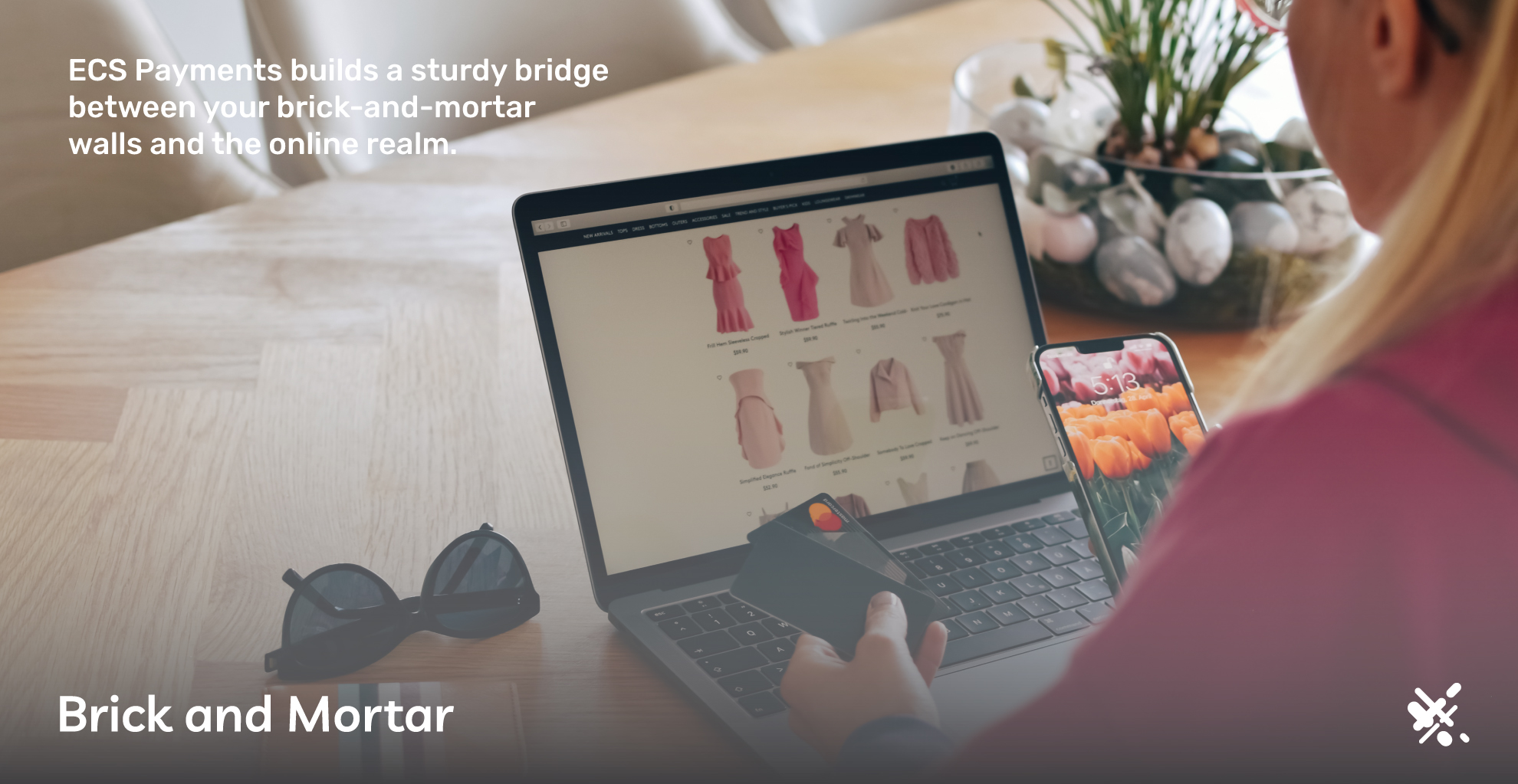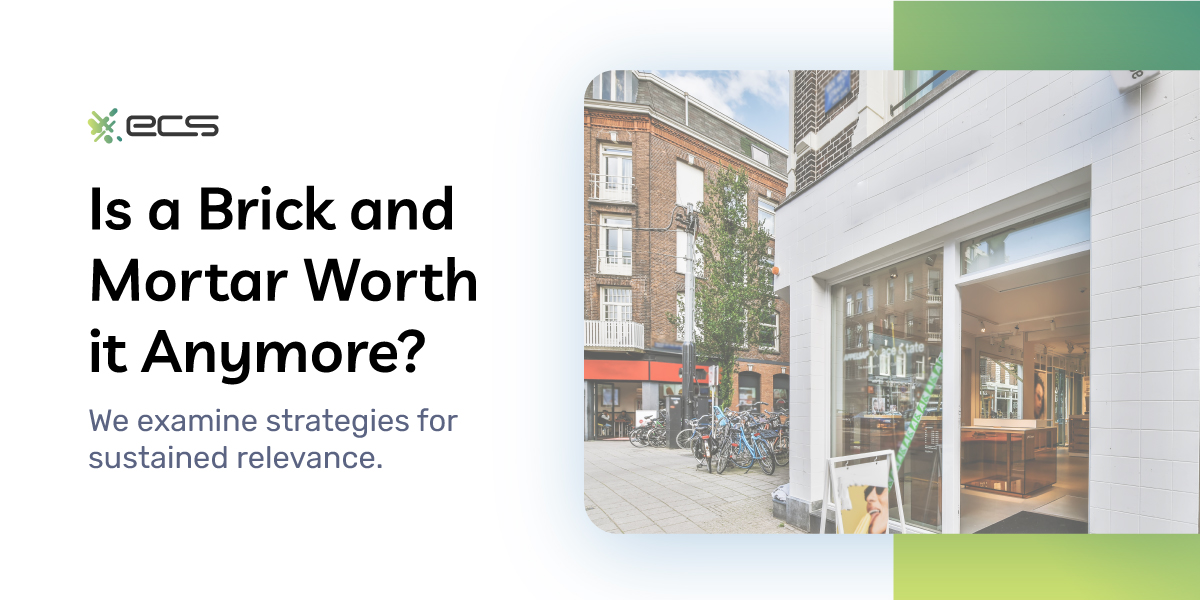A brick-and-mortar business is a physical “streetside” storefront where merchants sell goods or services face-to-face. Once upon a time, almost all businesses were brick-and-mortar enterprises. That all changed with the advent of online shopping.
There are more than 12-14 million eCommerce sites in the global marketplace today. 2.5 million of those businesses are based in the United States. By comparison, there are 1.06 million physical retail establishments in the U.S.
Around 70% of American consumers shop online regularly. Consumers can see proof of this everywhere they look: Amazon trucks zipping around town, delivering packages to online shoppers. And online retailers have become so ingrained in our cultural consciousness that brand names like Netflix have become verbs.
How did we get to this point, where online businesses outnumber physical stores more than 2 to 1? How did we reach the point where 64% of consumer shopping journeys start online? And most importantly, for retailers, do brick-and-mortar locations matter anymore?
Factors That Accelerated Brick and Mortar Closures
One factor that slowly killed off many brick-and-mortar retailers was the advent of online commerce. Online commerce relates to the purveyance of online goods and cloud-based or streaming services. For example, streaming services like Hulu and Netflix essentially displaced the consumer need for video rental stores like Blockbuster.
For many millennials, Blockbuster was a weekend ritual. You’d go into the store, browse the selection of videos, breathe in the scent of buttered popcorn, and beg your parents for candy. But what happened if they didn’t have the video you wanted? What happened if you returned it late and had to pay those fees?
Netflix had several advantages over Blockbuster. First off, nobody else was going to take your movie of choice: streaming services can deliver digital products to millions of households at the same time. There were no fees for late returns. And you didn’t have to do anything to return a video: be kind. Rewind isn’t going to make much sense to the next generation.
In summary, internet-based businesses offered consumers greater independence, convenience, flexibility, and overall value. Amazon, for instance, may have been a contributing factor in the deaths of Borders Books & Music and Toys R Us. At the time of this article, Sears is still slowly strangling to death in a dark-alley spectacle, like something out of a hardboiled detective novel (and Amazon is doing the strangling).

Those Who Do Not Innovate, Stagnate
But is the picture really as simple as that? As simple as the immortal words of the Buggles: “Video killed the radio star”? Taking our reference to Sears as a counterfoil, we see that similar stores like Target, Walmart, and Barnes & Noble have stayed in business. And perhaps the ultimate proof that the internet can’t kill off the brick-and-mortar economy is that Amazon itself is opening brick-and-mortar stores!
A more nuanced look at the slow death of big-name retailers reveals other factors. It’s not just that competitors killed off retailers like Borders Books. It’s that they failed to leverage the same technological waves that competitors were using.
Books, Nooks, and Kindles
For instance, Barnes & Noble has been able to compete with Amazon’s digital book business by offering their own line of digital “Nook” products. Let’s take a deeper dive.
Nobody can deny that Amazon has a whopping 85% of eBook sales, compared to B&N Nook’s 3%. But an examination of the products is important. 43% of the eBooks sold on Amazon are self-published. Have you ever published a book on Amazon?
If you haven’t, you should. Selling an eBook on Amazon is as easy as uploading a Word document and then charging people $2.99 to read it. Only 23% of Amazon eBook sales are by Big 5 Publishers, which involve a quality vetting process. Now over to the Nook: 26% are self-published, while 61% are Big 5 Publications.
In other words, when it comes to the purveyance of substantive, legacy-worthy material, Nook is holding its own against Amazon—which primarily offers an overwhelming sea of sub-par (if not interesting) bad advice about life topics and Lord of the Rings erotica (and maybe some fusion of the two).
Other Factors: Overextension and Debt
But we’re getting a little lost in the sauce here. At this point, we’re discussing two similar digital products. The point is that an online retailer (Amazon) primarily offers one, while a brick-and-mortar (Barnes & Noble) primarily offers the other.
Our point is that we shouldn’t just assume an online business will put its physical competitors out of business. If competitors can ride the tech wave, they will stay afloat.
Then there are other factors (aside from lack of innovation) that led to the death of these brick-and-mortar establishments. One was over-expansion. Corporations that stretch themselves too thin run the risk of bleeding dry.
A striking and recent example of this was the implosion of Washington Mutual Bank in 2008. There were several reasons why “WaMu” failed, but one significant one was that they over-expanded with too many branches.
Then there is bad debt. Several businesses have gone out of business due to debt. The aforementioned Toys R Us and Borders Books are two examples. Sometimes, a company can file for bankruptcy and resurrect itself.
But sometimes it can’t. Companies with lower debt-to-equity ratios can weather the storm of a bad economy or a global pandemic, which brings us to our next point.
The Impact of Covid-19 on Brick and Mortars
The COVID-19 pandemic seemed to be a death knell for physical retailers everywhere. Consumers were told to mask up and stay six feet apart. They were told to stay at home unless they needed essential items like food, toiletries, and alcohol (to cope with the kids who were home due to school closures).
Several recognizable brands closed their doors for good, including Pier1 Imports—leaving many consumers to wonder where they would purchase conversation-sparking, gentrified exotica.
Covid negatively impacted some sectors far more than others. The hospitality sector, for example, suffered 8 million job losses, the largest of any sector. Covid chaos highly impacted one particular sub-sector of the hospitality industry-the restaurant business.
Around 11% of the nation’s restaurants closed their doors, some for good. Many of these were local establishments that served as community focal points. Their prominence in the local eye made consumers acutely aware of their brick-and-mortar death, far more painful than might a faceless entity like a nearby big-box store.
Overall, we cannot say that internet businesses killed the restaurant industry. In fact, internet-based applications like DoorDash and GrubHub allowed some diners to continue patronizing these establishments.
They could take their weekly $600 FPUC money and spend it on a $30 delivery of Starbucks nearly as often as they liked. Those restaurants that did shutter their doors for good did so because of circumstances that, in hindsight, were way beyond anybody’s control.
Social and Legislative Factors Impacting Storefronts
Or were they? Government response to natural disasters and pandemics can make or break the economy. And so can the government’s response to social trends. Without becoming polarizing, it is not debatable that in specific locations, the implementation of revamped bail policies has encouraged crime, such as large-scale smash-and-grabs.
If you don’t believe it, believe that 50% of the retailers have left San Francisco. And they aren’t singing anything about leaving their heart there. Nearly two dozen big names like Anthropologie, Old Navy, Nordstrom, and Banana Republic are heading for places that are…well, a little less like the Banana Republic. Brick-and-mortar retailers simply cannot put up with massive crime waves.
However, there is an upshot of this developing story (which will continue developing until stealing less than $950 in merchandise is once again a crime). The upshot is that brick-and-mortar retail is no longer worth it in places like Union Square (in San Francisco).
However, brick-and-mortar establishments may be well worth it in markets where law-abiding consumers engage in normal shopping habits. Like…you know, not stealing stuff.


Brick and Mortar For Life
Some businesses are inherently brick and mortar. Restaurants, bars, hotels, casinos, and venues for live entertainment are all inherently brick-and-mortar business types. So are grocery stores, gyms, beauty salons, spas, health clinics, and houses of worship (considering that a non-profit is a type of business).
The overarching trend here is that businesses cannot render some aspects of goods or services virtually. You can indeed have chicken wings delivered to your house. But can you eat them in a booth tucked into a panoply of bizarre kitsch items interlaced with pictures of the local fire department? No, you cannot. So, let’s head to Applebees.
What many of these places have in common is ambiance and/or experience. Anything involving hospitality needs a physical location because customers seek an escape from their homes. Then, there are businesses like spas, salons, and health clinics. These places offer tangible physical services that consumers cannot get virtually.
Yes, there has indeed been an increase in telehealth. But you cannot get a telemessage, a telehaircut, or get your telenails done. And lastly, there are business types like grocery stores and drug stores. While an in-person shopping experience is not strictly necessary, there are times when consumers need something now.
The Importance of Consumer Experience
Let’s focus on the aspect of consumer experience. As mentioned, some business types inherently cater to a consumer’s need for ambiance and experience. But what about businesses that aren’t? Does this lessen the need for such a business to have a streetside, tangible storefront?
Let’s return to our earlier example with Blockbuster. Part of what made renting videos so appealing was the experience. Sight, sound, taste, touch, and smell augmented the rental of Ninja Turtles or The Notebook.
You touched the actual product (skimming videos wrapped in that memorable plastic), you saw some cool covers of potentially good movies), and you could smell the popcorn and practically taste it in your mouth.
Coffee and Meatballs: Creating The In-Store Experience?
Brick-and-mortar retailers are now attempting to create experiences in their stores. This makes the store more than a functional destination for making a purchase. Department stores have used this strategy for a long time, with cafes placed inside their stores. A university study found that shoppers consuming caffeine spent 50% more on 30% more items than shoppers who didn’t imbibe.
Using caffeine to encourage impulsive decision-making may benefit services mentioned above businesses like spas and salons. Many such locations have the practice of offering a little cafe-con-leche to waiting customers.
Perhaps these customers may go beyond what they were coming in for that extra beauty treatment. Either way, offering a drink creates a bonding, social experience that transcends mere transactionality.
Another retailer that has successfully leveraged the idea of experience is IKEA. Consumers are fascinated by the trendy aesthetic of IKEA’s product offerings—furniture and smaller household items like cookware. They appreciate (nay, marvel at) the pricing points. And it is also an entertaining experience to shop. Not to mention the delicious cafeteria to curb the appetite that all that shopping worked up.
That’s because consumers at IKEA who ascend the escalator are not just dropped off in a large, soulless, fluorescent-lit room. There is no grid-like aisle layout reflecting the Spanish colonial Laws of the Indies. Instead, there is a meandering maze of different rooms. Each one is thematically decorated, showcasing the best of IKEA’s offerings.
Moving through the IKEA store is almost like taking an amusement park ride. Shoppers turn a corner and are greeted with the pleasant surprise of a tastefully decorated living space. Wow, there’s another one. Hey, did you see what this room looks like? Immersed in this fascinating design and style showcase, they forget how frustrating it is to put the furniture together.
At the end of their journey, meatballs await, supplemented by exotic food items in packaging with unpronounceable words. In all, IKEA has made its brick-and-mortar locations into something consumers cannot replicate at home. And while you may not be able to do it at their scale, you can certainly take the idea of store displays to heart.
Store Displays, VR, and AR
Store displays have long been a part of brick-and-mortar businesses. They are an evergreen component of the grocery store business (stack ’em high, watch them fly). And they are a huge part of the seasonal atmosphere, especially around holiday time.
Our cultural anticipation of evergreen and red ribbons come December is so prevalent that even online retailers attempt to replicate the decor graphically on their websites.
Virtual and augmented reality may take brick-and-mortar in-store displays to the next level. Companies like Nike use AR technology where customers can scan items and learn more about the supply chain—combining customer desires for transparency with the wow factor of immersive experiences. In 2019, Nike brought VR technology to its New York store so customers could try on products in different “environments.”

Why Banks Are Opening More Branches
Banks have long been a traditional brick-and-mortar business. However, in recent times, most consumer banking is facilitated electronically. Around 41% of consumers use no cash for purchases during the week. Consumers can deposit their paychecks directly and pay for everything with credit and debit cards. So why are banks continuing to build branches?
To answer that question, we need to consider consumer deposits—from the bank’s perspective. Banks collect consumer deposits and then loan that money for consumer and business loans. The more deposits they can collect, the more they have to lend.
Brick-and-mortar bank branches are essentially billboards that say: come put your money here. Chase and Bank of America announced that within the next decade, they aim to open 400-500 new branches.
And banks are investing in making their branches look appealing. For instance, Chase recently opened a 12,000-square-foot branch (the largest in the country) in Midtown Manhattan.
These local bank branches also facilitate building deeper customer relationships. Personalized conversations can unfold in the banking center that could not occur online. For instance, a banker cashing a check or opening a savings account could start discussing other products like car loans, mortgages, credit cards, and HELOCS.
So here are a few lessons to take away from banks: a brick-and-mortar footprint can help build brand awareness. In the case of banks, customers may start depositing their money in the branches with the trendiest look and best customer service. Brick-and-mortar footprints also provide a better opportunity for upselling your existing goods or services.
Why Services Need Brick and Mortar Locations
That brings us to our next question. Do service-based businesses need brick-and-mortar locations? Sometimes yes, sometimes not. If your service-based business involves meeting clients in person, you need a brick-and-mortar location.
Tax advisors, lawyers, insurance agents, doctors, and realtors are all professionals who need to meet with clients in person. Asking the client to meet you at Starbucks does not always send the best message. Some clients may not mind reviewing their tax returns to some smooth jazz in the background, but others will find it annoying.
Service-based businesses can also use an office location for internal meetings. This will be much more convenient than (once again) meeting in Starbucks or your living room. Like banks, a physical location can also effectively advertise your business to new clients and customers.
Building Brand Recognition
One of the benefits of brick-and-mortar stores is that they build brand recognition, especially in areas with significant foot traffic. A business owner will struggle to give their products and services a significant online presence. For starters, there are already 2.5 million domestic businesses to compete against.
Then, there is the fact that you are essentially swimming upstream in terms of capturing customer attention. Social media users are bombarded with ads for everything, so much so that attention spans have dipped below that of a goldfish (glub, glub).
By contrast, a physical storefront in a good location can benefit naturally from foot traffic. Retail businesses in busy malls or vibrant commercial districts are getting their name in front of people. Of course, the retailer must follow up this initial introduction with a positive customer experience inside the store.
Brick and Mortar Disadvantages
Before we bring it on home with the brick-and-mortar pros, let’s examine a few brick and mortar “cons.: The brick-and-mortar business model does mean you’ll have to pay rent or property taxes (if you own the property). This can be a significant expense.
Even so, you can always write these expenses off against your income. There are also tax strategies like depreciation. Depreciation can be applied to landed property or even movable property. This dollar amount reflects the money you have to spend on the “maintenance” of your property. You can only claim a tax break if you have property to depreciate.
Brick-and-mortar locations can also become the scene of lawsuit-triggering liabilities. However, you can have liability insurance to cover these types of incidents. In any case, you will only want to shoulder these costs (rent, mortgage, taxes, utilities, insurance) if profits outweigh them. The most profitable brick-and-mortar businesses have found that their profits do indeed outweigh these costs.
Brick and Mortar Benefits
Now, on to examining the data and answering our initial question: Are brick-and-mortar businesses worth it anymore?
Consumers seem to prefer shopping in person, despite our cultural assumptions. Roughly 40% of consumers make at least one in-store purchase per week, while only 27% of online shoppers make weekly purchases.
Consumers enjoy shopping in person because they can avoid delivery fees (65%), they can get their items immediately (60%), and they can try their items on (61%). As for food, consumer preferences are even stronger: nearly 82% of consumers prefer buying groceries in person rather than online.
As of 2021, even during the height of the Pandemic, 80% of shoppers worldwide completed their purchases in stores, and 20% made purchases online. U.S. brick-and-mortar stores sold over $6.4 trillion in merchandise during 2022, and experts project that they will see $7.2 trillion by 2026. Moreover, brick-and-mortar sales growth outpaced eCommerce growth by 11.4% in the same period.
In summation, it would seem that consumers still prefer shopping in person for many reasons. Additionally (as mentioned), physical locations create better opportunities for upselling or enrolling customers in loyalty programs. They also help build brand awareness by advertising your business.

Why Amazon is Opening Stores
As seen, consumers enjoy immediate convenience, especially when purchasing food and consumer staples. Amazon has not yet learned how to beam items into your house like Star Trek. So the next best thing is opening physical storefronts.
Amazon also hopes to tap into the aforementioned experiential ideas of in-person retail shopping as a fun experience. Store interiors will be shaped with looks inspired by social media influencers. Consumers who resonate with the personal brand of such influencers will find shopping in Amazon stores a very personalized experience.
The Halo Effect
The International Council of Shopping Centers found that when a retailer opens a new brick-and-mortar location, online traffic increases 37%. The positive correlation between bricks and clicks has been dubbed “The Halo Effect.” Yet, the same effect exhibited the opposite direction: online traffic dropped when a physical store closed.
The effect is easier to understand when considering the social signal a storefront sends. When consumers see a store closing, they associate that closure with the brand as a whole. It might only be that individual store that isn’t doing well, but they’ll conflate that with the health of the entire brand.
Conversely, when consumers see thriving storefronts, they’ll have a more positive image of the brand. Small to midsize businesses may wonder how they can compete with corporations that drop multiple storefronts into one zip code.
Remember that a significant part of the brick-and-mortar business idea is what the store looks like inside. If you have a clean, organized, and well-stocked retail store, this will create a positive image of your brand. In turn, this can lead to more online sales when consumers are at home. They will think of your brand and head to your online store.
Brick and Mortar Wrap Up
Brick and mortar is a streetside, physical location for retail sales or services. While several brick-and-mortar retailers have folded through the rollout of eCommerce, and during the Covid Pandemic, statistics show that in-person shopping is thriving.
Moreover, research has shown that a joint offering of online and in-person shopping improves sales in both areas. This idea fits into the omnichannel existence of consumers today, who tend to have multiple social media accounts.
In-person and online shopping require very different payment processing solutions, however. And yet, it’s possible to manage both solution sets under one umbrella. If you have questions about online or in-store payment processing, reach out. Give us a call or fill out the contact form below. We’d love to hear more about your business, whether online, brick-and-mortar, or both.
Frequently Asked Questions About eCommerce Vs. Brick and Mortar Businesses
Yes! Brick-and-mortar businesses remain crucial. While the rise of eCommerce is undeniable, consumers still appreciate and, in fact, need specific in-person shopping experiences such as restaurants, self-care, and more. Businesses with a well-designed brick-and-mortar presence can leverage the “Halo Effect” to enhance brand perception and drive in-store and online sales. ECS Payments recognizes the importance of a dual approach for businesses. We offer comprehensive payment processing solutions for both online and brick-and-mortar operations.
Yes, brick-and-mortar stores offer immediate satisfaction. Customers can avoid delivery fees, try on items, and make purchases instantly without waiting on shipping times. In-store experiences foster brand awareness, encourage upselling, and build customer loyalty when partnered with a memorable customer experience. ECS Payments understands the unique needs of physical retail locations. Contact us to receive tailored payment processing solutions to enhance the overall customer experience and streamline your business.
Successful brick-and-mortar businesses focus on creating a unique in-store experience for their customers. They offer personalized services which help to build a positive brand image. In fact, thriving physical storefronts also positively impact online traffic for their business. ECS Payments can assist your business with navigating both online and in-person payment processing to ensure a seamless and positive customer experience.
Embracing an omnichannel approach is vital to success in the modern retail market. It requires seamless integration of payment processing solutions. ECS Payments provides comprehensive and custom-tailored payment processing solutions catering to online and physical retail environments.
